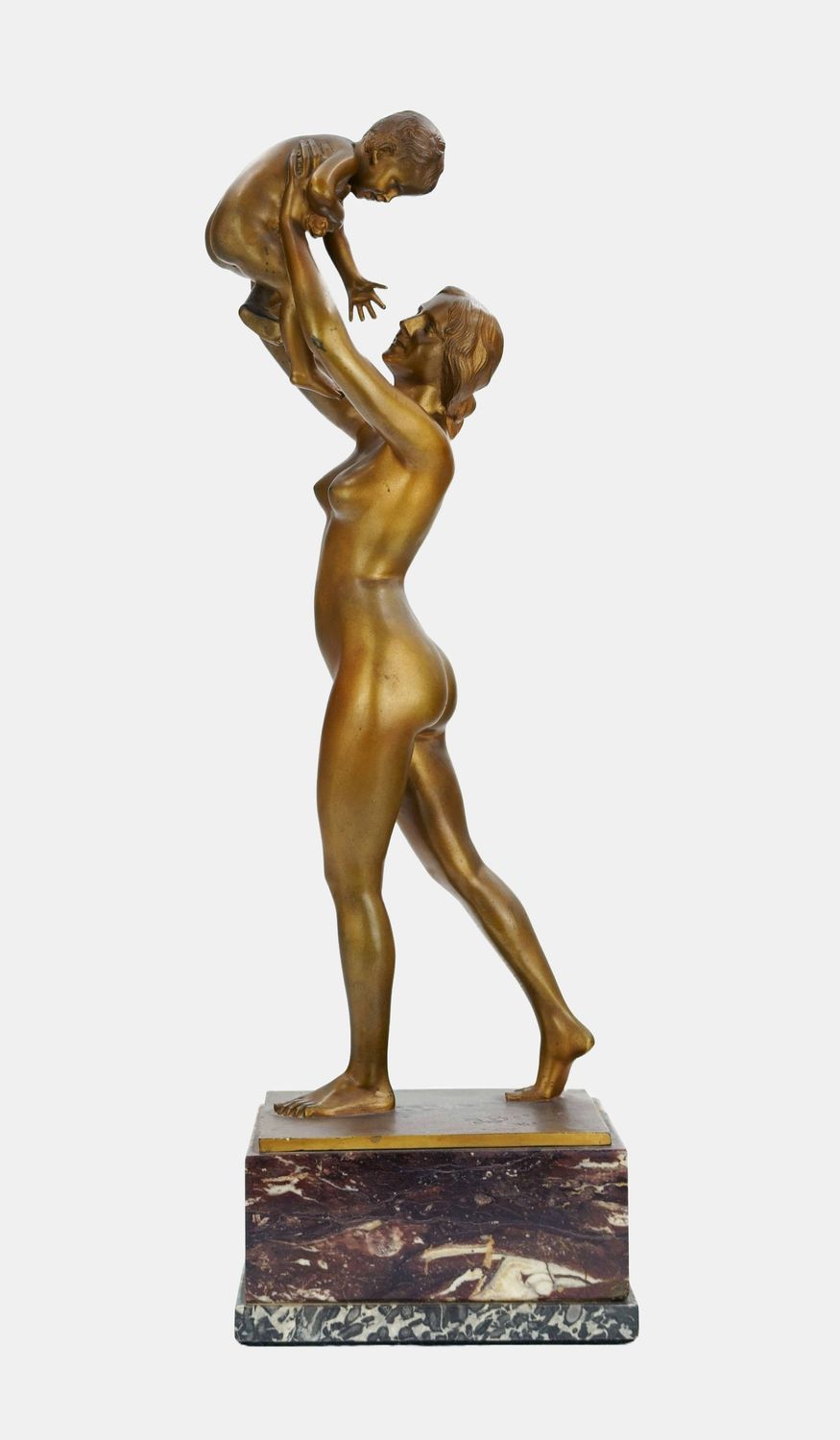Boese, Johannes (1856-1917), Mother Happiness, c. 1910
Johannes Boese(1856 Ostrog - 1917 Berlin), Mother Happiness , around 1910. Gold-brown patinated bronze on a cast rectangular plinth, mounted on a two-tone marble base (9.5 cm high), total height 61 cm, dimensions of the bronze: 50.5 cm (height) x 18 cm (length) x 11.5 cm (width), weight 12 kg, signed on the plinth "J.[ohannes] Boese" and inscribed with "Berlin".
- Patina somewhat rubbed and slightly stained in places, plinth and marble base with some dents, one corner restored.
- The ecstasy of maternal joy -
While Johannes Boese had devoted himself primarily to monumental sculptures commissioned by the state and representative portraits , this work illustrates that the artist also followed his own ideas and, although he followed the Wilhelmine state style, he was also inspired by Art Nouveau.
We see a mother striding out, joyfully lifting her boy into the air and gazing happily into his eyes. The child returns the gaze with the same intimacy, extending a hand toward the mother. The spread fingers show the unfulfilled desire to touch her. With his high forehead and broad cheeks, the boy looks like a secular putto, betraying Boese's Wilhelminian Baroque origins and adding an allegorical dimension to the depiction. With his other hand, the boy clutches a doll, making him appear thoroughly human. The natural-looking kicking movements illustrate him as the epitome of the childlike child.
The mother's face, with its elongated, straight nose, has antique features, while her body stands before us in antique nudity, which also gives the sculpture an allegorical dimension in terms of the representation of the mother. However, the contrapposto of classical sculpture, with its supporting and free leg, has become an extension. The body, resting in itself, is set in an almost tempestuous motion, carried by an inner movement.
The sculpture tells a story, the climax of which can be seen here: The mother has seen her son from afar, rushes to him and lifts him up to the sky with joy and maternal pride, while the son is filled with the feeling of finally being with his mother again, whom he also wants to caress.
If the image of motherhood is characterized not least by Mary with the Christ Child, Boese creates here an image of the joy that belongs to motherhood, which takes on ecstatic, dance-like traits, as if the mother were performing a dance of joy that culminates in the moment shown. By tracing the different views of the bronze sculpture, the dancing, ecstatic movement is continually reinitiated by the viewer.
The beauty of the naturalistically modeled female body radiates maternal happiness, which is made to glow by the golden patina. The eros of her naked beauty is completely absorbed in the joy of the fruit of her womb.
About the artist
After training as a woodcarver, Johannes Boese first attended the School of Arts and Crafts in Gliwice. Following his real talent as a sculptor, he entered the Berlin Academy of Art in 1877 and studied there until 1883 under Fritz Schaper and Albert Wolff, whose master student he became. Wolff was one of the leading artists of the Berlin School of Sculpture, founded by Johann Gottfried Schadow and his pupil Christian Daniel Rauch.
Boese received his first recognition with the 1883 work Narcissus, which won a prize at the 1888 World's Fair in Melbourne. Larger commissions followed, such as the 1885 relief "Reception of the Huguenots by the Great Elector" in the French Cathedral at the Gendarmenmarkt. In 1887, with the aid of a reading magnifier, he created the bronze statue of Emperor Wilhelm I. Several copies were purchased by Wilhelm II, making Boese one of the emperor's favorite artists and earning him numerous state commissions. For example, he was allowed to create the fourth group of monuments for Berlin's then famous Victory Avenue without having to take part in the competition. His statue of Albrecht II in the company of Eike von Repgow, the author of the Saxon Mirror, and Hermann von Salza, the most important Grand Master of the Teutonic Order, completed in 1898, made Boese one of the most sought-after state artists. In the following years he mainly created monumental sculptures depicting potentates of the ruling dynasty. For his monument to Emperor Frederick III, erected in Posen in 1902, Boese was appointed professor at the Berlin Academy of Art. One of his students was Georg Meyer-Steglitz, who also created monumental works, most of which are now lost.

